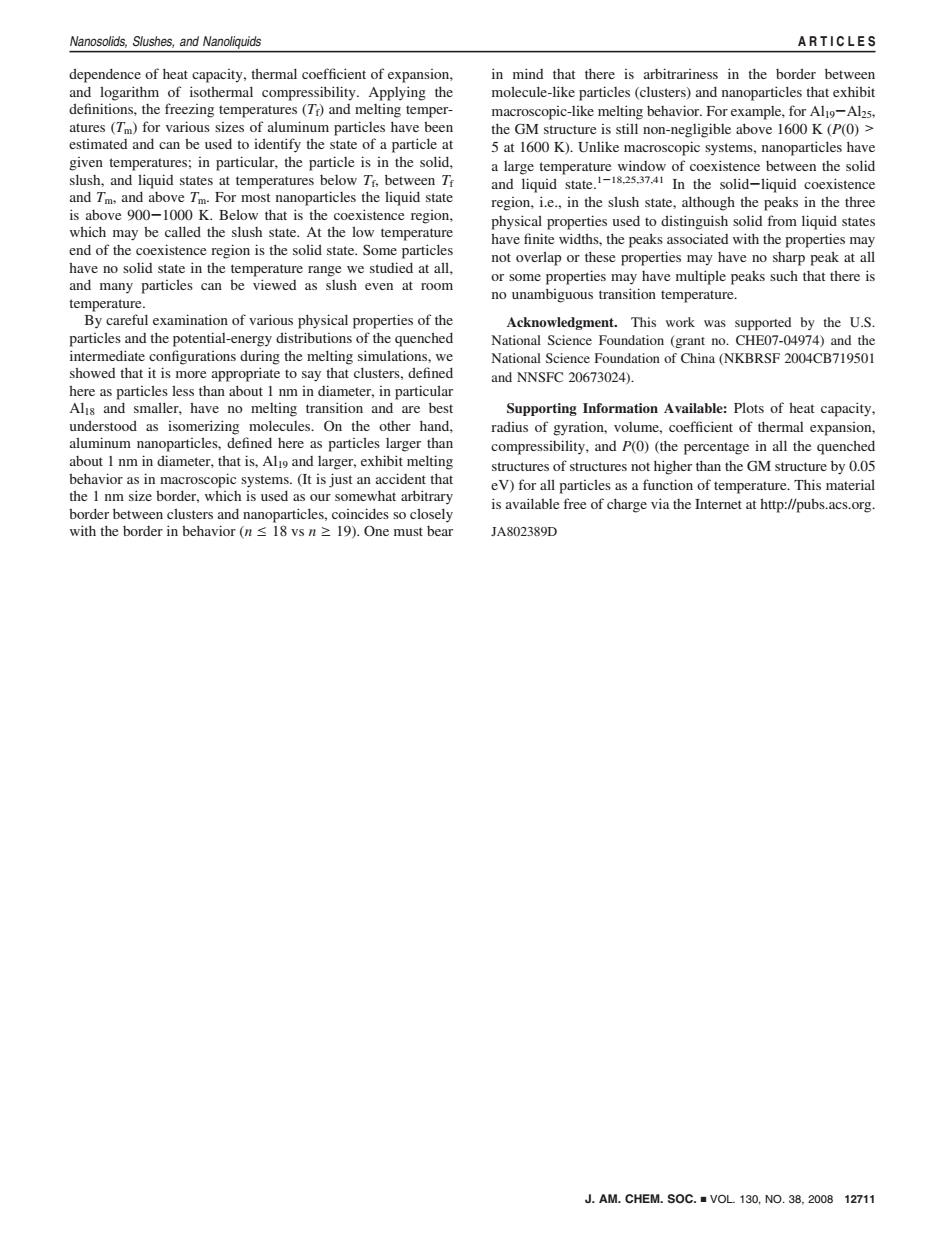正在加载图片...

Nanosolids,Slushes,and Nanoliquids ARTICLES dependence of heat capacity,thermal coefficient of expansion, in mind that there is arbitrariness in the border between and logarithm of isothermal compressibility.Applying the molecule-like particles(clusters)and nanoparticles that exhibit definitions,the freezing temperatures(Tf)and melting temper- macroscopic-like melting behavior.For example,for Al9-Al2s. atures (Tm)for various sizes of aluminum particles have been the GM structure is still non-negligible above 1600 K (P(0)> estimated and can be used to identify the state of a particle at 5 at 1600 K).Unlike macroscopic systems,nanoparticles have given temperatures;in particular,the particle is in the solid. a large temperature window of coexistence between the solid slush,and liquid states at temperatures below Tr,between Tr and liquid state.-1825.3741 In the solid-liquid coexistence and Tm and above Tm.For most nanoparticles the liquid state region,i.e.,in the slush state,although the peaks in the three is above 900-1000 K.Below that is the coexistence region, which may be called the slush state.At the low temperature physical properties used to distinguish solid from liquid states have finite widths,the peaks associated with the properties may end of the coexistence region is the solid state.Some particles not overlap or these properties may have no sharp peak at all have no solid state in the temperature range we studied at all, or some properties may have multiple peaks such that there is and many particles can be viewed as slush even at room no unambiguous transition temperature. temperature. By careful examination of various physical properties of the Acknowledgment.This work was supported by the U.S. particles and the potential-energy distributions of the quenched National Science Foundation (grant no.CHE07-04974)and the intermediate configurations during the melting simulations,we National Science Foundation of China (NKBRSF 2004CB719501 showed that it is more appropriate to say that clusters,defined and NNSFC 20673024). here as particles less than about 1 nm in diameter,in particular Alis and smaller,have no melting transition and are best Supporting Information Available:Plots of heat capacity, understood as isomerizing molecules.On the other hand, radius of gyration,volume,coefficient of thermal expansion, aluminum nanoparticles,defined here as particles larger than compressibility,and P(0)(the percentage in all the quenched about I nm in diameter,that is,Al and larger,exhibit melting structures of structures not higher than the GM structure by 0.05 behavior as in macroscopic systems.(It is just an accident that eV)for all particles as a function of temperature.This material the 1 nm size border,which is used as our somewhat arbitrary border between clusters and nanoparticles,coincides so closely is available free of charge via the Internet at http://pubs.acs.org. with the border in behavior (n 18 vs n2 19).One must bear JA802389D J.AM.CHEM.SOC.VOL 130,NO.38,2008 12711dependence of heat capacity, thermal coefficient of expansion, and logarithm of isothermal compressibility. Applying the definitions, the freezing temperatures (Tf) and melting temperatures (Tm) for various sizes of aluminum particles have been estimated and can be used to identify the state of a particle at given temperatures; in particular, the particle is in the solid, slush, and liquid states at temperatures below Tf, between Tf and Tm, and above Tm. For most nanoparticles the liquid state is above 900-1000 K. Below that is the coexistence region, which may be called the slush state. At the low temperature end of the coexistence region is the solid state. Some particles have no solid state in the temperature range we studied at all, and many particles can be viewed as slush even at room temperature. By careful examination of various physical properties of the particles and the potential-energy distributions of the quenched intermediate configurations during the melting simulations, we showed that it is more appropriate to say that clusters, defined here as particles less than about 1 nm in diameter, in particular Al18 and smaller, have no melting transition and are best understood as isomerizing molecules. On the other hand, aluminum nanoparticles, defined here as particles larger than about 1 nm in diameter, that is, Al19 and larger, exhibit melting behavior as in macroscopic systems. (It is just an accident that the 1 nm size border, which is used as our somewhat arbitrary border between clusters and nanoparticles, coincides so closely with the border in behavior (n e 18 vs n g 19). One must bear in mind that there is arbitrariness in the border between molecule-like particles (clusters) and nanoparticles that exhibit macroscopic-like melting behavior. For example, for Al19-Al25, the GM structure is still non-negligible above 1600 K (P(0) > 5 at 1600 K). Unlike macroscopic systems, nanoparticles have a large temperature window of coexistence between the solid and liquid state.1-18,25,37,41 In the solid-liquid coexistence region, i.e., in the slush state, although the peaks in the three physical properties used to distinguish solid from liquid states have finite widths, the peaks associated with the properties may not overlap or these properties may have no sharp peak at all or some properties may have multiple peaks such that there is no unambiguous transition temperature. Acknowledgment. This work was supported by the U.S. National Science Foundation (grant no. CHE07-04974) and the National Science Foundation of China (NKBRSF 2004CB719501 and NNSFC 20673024). Supporting Information Available: Plots of heat capacity, radius of gyration, volume, coefficient of thermal expansion, compressibility, and P(0) (the percentage in all the quenched structures of structures not higher than the GM structure by 0.05 eV) for all particles as a function of temperature. This material is available free of charge via the Internet at http://pubs.acs.org. JA802389D J. AM. CHEM. SOC. 9 VOL. 130, NO. 38, 2008 12711 Nanosolids, Slushes, and Nanoliquids ARTICLES